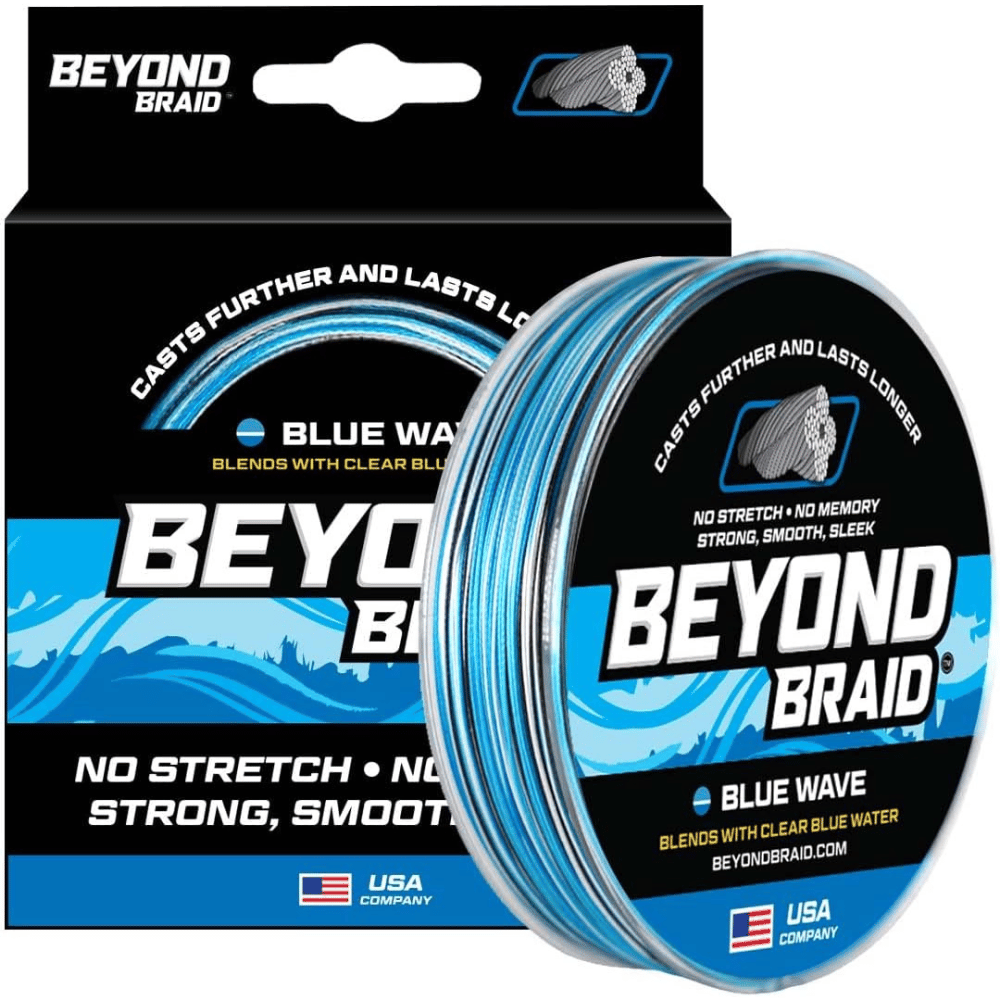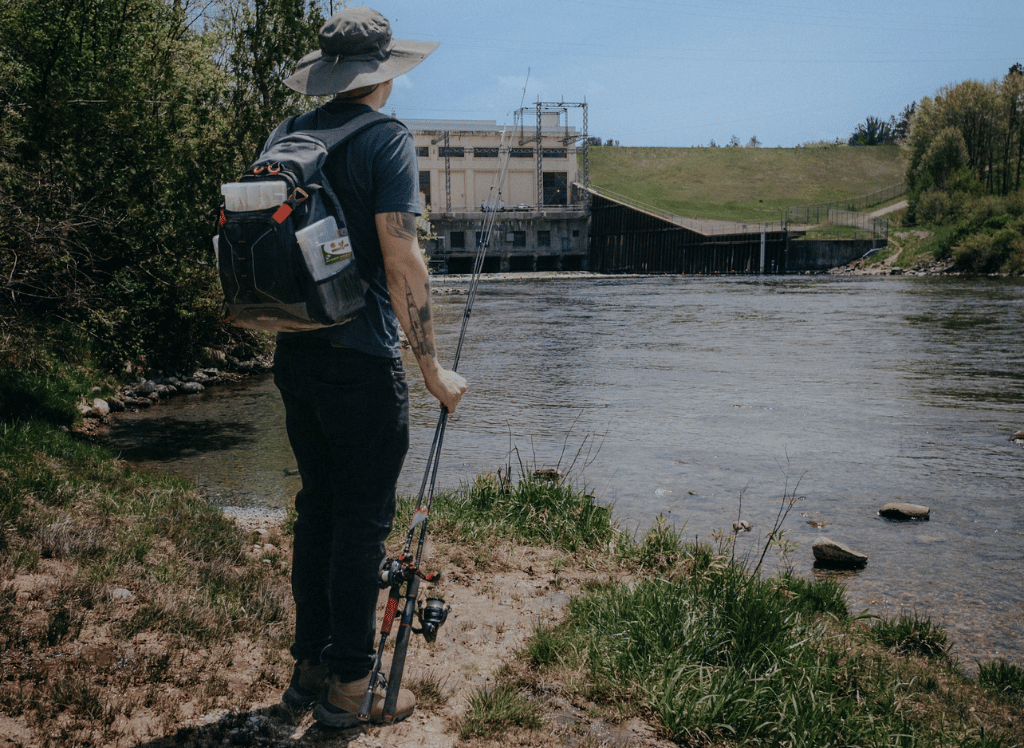What's the big deal about fishing lines? Well, think of your fishing line as the invisible link between you and that trophy fish. The right line can make a world of difference.
We're going to reel in the details about the top fishing lines for spinning reels. We've got the lowdown. Maybe we'll even throw in some handy tips.
So, grab your fishing hat, tighten your reel, and let's cast off into the sea of knowledge. By the end of this article, you'll have all the bait you need to make an informed choice about a fishing line for your spinning reel. You'll get to:
- Understand the differences between monofilament, fluorocarbon, and braided fishing lines for spinning reels.
- Learn about the importance of line twist, memory, and abrasion resistance in selecting the right fishing line.
- Discover practical tips for line management to enhance your spinning gear performance.
Monofilament Fishing Line
Monofilament lines have been the go-to choice for many anglers for years. Their ease of use and affordability make them a popular option for those just starting with spinning tackle. Monofilament is known for its stretch, which can be a big deal when fighting a fish, as it provides shock absorption. However, this stretch can also be a downside because it reduces sensitivity, making it harder to feel a bite.
Trilene XL is one example of a monofilament line that offers low memory and smooth casting, making it a best bet for many anglers. Its clear water performance is notable, and it's versatile enough to tie various lures effectively. The stretch of mono line can be an advantage in certain situations, such as when using treble-hooked lures, as it can prevent the hooks from tearing out of the fish's mouth.
Fluorocarbon Line
Fluorocarbon lines are often praised for being virtually invisible underwater, which is a significant advantage in clear water conditions. This invisibility can make a difference when targeting skittish fish that are easily spooked by the sight of a line. Fluorocarbon also has very low stretch, providing excellent sensitivity to detect even the slightest bites.
Another benefit of fluorocarbon is its abrasion resistance, which is crucial when fishing around structures that can break your line. A fluorocarbon leader tied to your main line can be a game-changer, especially in clear water where fish might be line-shy. However, fluorocarbon can be more challenging to manage due to its memory, which can lead to more line twists and wind knots if not handled correctly.
Braided Fishing Line
Braided fishing lines are known for their incredible strength and small diameter, allowing for longer casts and more line on your spool. Braid line is also highly sensitive, with virtually no stretch, making it easier to feel bites and the bottom structure. This sensitivity makes braided lines a favorite for bass fishing and other scenarios where a strong, immediate hookset is needed.
However, braided lines can be visible to fish, which is why many anglers use a fluorocarbon leader to maintain stealth. Braid line also has no memory, which means fewer issues with line twists. But, it's essential to ensure that your spinning reel can handle braid line, as not all reels are designed for the unique properties of braided lines.
Understanding Line Twist and Its Impact
Line twist is one of the most common issues faced by anglers using spinning reels. It can cause tangles, knots, and poor casting performance. Monofilament and fluorocarbon lines are more prone to line twist than braided lines. To minimize line twist, it's crucial to use the correct line management techniques, such as not overfilling the spool and closing the bail by hand after casting.
The Role of Line Memory in Casting Performance
Line memory refers to the line's tendency to hold the shape of the spool, which can affect casting distance and accuracy. Lines with high memory can form coils when cast, reducing casting distance and causing tangles. Low memory lines, like Trilene XL for monofilament and some fluorocarbon lines, offer smoother casts and less hassle on the water.
Abrasion Resistance for Rough Conditions
When fishing in areas with heavy cover, rocks, or structures, abrasion resistance becomes a critical factor. Fluorocarbon lines offer excellent abrasion resistance, allowing you to fish in these challenging conditions with more confidence. Braided lines also perform well in terms of abrasion resistance, but their visibility might require the use of a leader.
Line Management
Proper line management is essential for maintaining the performance of your spinning gear. This includes regularly checking your line for nicks and frays, especially after a few weeks of heavy use. Replacing your line or trimming away damaged sections can prevent unexpected break-offs that could cost you a catch.
Saltwater Fishing
Saltwater fishing presents unique challenges, including the corrosive nature of saltwater and the potential for larger, more powerful fish. In these conditions, a braided line with a strong fluorocarbon leader is often the best bet. The braid's strength and small diameter allow for more line on the spool, which is crucial when a big fish takes a long run.
Wind Knots
Wind knots are a common problem with spinning reels, often caused by line twist and improper spooling. They can be minimized by using a line with low memory and ensuring that the line is laid on the spool evenly and with appropriate tension. Braided lines, with their low memory, can help reduce the occurrence of wind knots.
Maximizing Casting Distance with the Right Line
For many anglers, casting distance is a significant factor, especially when trying to reach distant cover or points. A line with a small diameter, like a braid line or some fluorocarbon lines, can help achieve longer casts. Additionally, lines with low memory will cast more smoothly, further aiding in reaching those far-off spots.
Choosing the Pound Test
The pound test of your fishing line should be chosen based on the species you're targeting and the conditions you're fishing in. A higher pound test will provide more strength but can be more visible to fish. Conversely, a lighter line will be less visible but may break more easily. It's a balance that each angler must strike based on their specific fishing trips.
The Market's Best Lines for Spinning Reels
Several different lines on the market are well-suited for spinning reels. Brands like PowerPro for braided lines and Seaguar for fluorocarbon lines offer high-quality options that many anglers trust. When selecting a line, consider not only the type but also the brand's reputation for quality and performance.
Tying It All Together
The type of line you choose can also affect the knots you tie and the lures you use. Some lines are more slippery, requiring specific knots to secure them properly. Additionally, the stretch and sensitivity of the line can influence how a lure behaves in the water, so consider how your line choice will work with the lures you plan to use.
Hearing from the Pros
Professional anglers often have preferences for certain lines based on their extensive experience. Listening to their advice can provide insights into why they choose one type of line over another for specific situations. Whether it's for abrasion resistance, casting distance, or sensitivity, the pros have valuable knowledge to share.
Covering All Points
Different fishing scenarios call for different types of lines. For example, in clear water, a fluorocarbon line might be the best choice, while in murky water, the visibility of the line is less of an issue, and a braided line's strength could be more important. Understanding the conditions and the behavior of the fish you're targeting will guide your line choice.
The Bite
The type of line you use can affect your ability to detect a bite and respond quickly. A line with low stretch and high sensitivity, like a braided line, will transmit more information from the end of the line to your hand, allowing for a faster and more decisive hookset.
How We Choose the Best Fishing Line for Spinning Reels
Selecting the ideal fishing line for spinning reels is a meticulous process that involves thorough research and consideration of key factors. We delve into the specifications, scrutinizing line weight compatibility with the reel's capacity for optimal performance. Material composition is pivotal, ensuring strength, sensitivity, and durability. Our exploration extends to user reviews and expert insights, gauging the real-world experiences of fellow anglers. We prioritize lines with minimal memory, promoting smooth casting and fewer tangles. The knot strength and abrasion resistance are non-negotiables, addressing the challenges of different fishing environments. Crafting a comprehensive guide, we navigate the sea of options to assist fellow anglers in making informed choices.
🏅 Beyond Braid Braided Fishing Line
why we ❤️ this fishing line
For a first-time "Beyond Braid line" user, the impression is remarkable. Its extreme smoothness, small diameter, exceptional casting ability, and high abrasion resistance stand out. The price is exceptional, offering a 500-yard spool for less than half the cost of some high-advertised brands while matching their quality. This experience led to purchasing more in varying line weights. As a fishing guide spending over 250 days annually on water, cost matters greatly. Recommending this product wholeheartedly, urging others to experience it themselves. Beyond Braid is go-to for ALL fishing gear, ranging from 20lb to 50lb—it's fantastic. Its camo blends seamlessly in most French water conditions, ensuring no trouble in catching fish. While the color does fade over time, it’s not as severe as some Power Pro and Spiderwire I’ve tried. The quality and value are truly amazing!
🎣 features
Crafted from Polyethylene, Beyond Braid's braided fishing line, boasting a 30-pound breaking strength, redefines angling standards. The blue wave color and multi-strand construction epitomize durability and performance. Its compact package dimensions of 4.92 x 3.98 x 0.91 inches, with a lightweight of 0.07 kilograms, promise ease of handling and storage. Designed to offer 300 yards of robust line, this product emphasizes strength and reliability for varied fishing conditions. Developed by Beyond Braid, this line is a testament to quality and innovation, catering to anglers seeking superior performance and endurance in their fishing lines. Coated with a smooth fluoropolymer, it enhances casting efficiency, facilitating longer and precise casts while boasting a thinner diameter for increased reel capacity. Its zero-stretch PE fibers deliver unparalleled sensitivity, translating to immediate bite detection and swift hooksets, amplifying hookup success. This ultra-strong braid is abrasion-resistant, excelling in challenging environments, from structures to heavy cover, ensuring durability in tough situations. Sporting a blue camo design, it seamlessly blends into open blue waters, evading fish detection.
Fishing Line for Spinning Reels FAQs
Browse our Frequently Asked Questions section for optimal spinning reel fishing lines, focusing on weight, material, and durability. Uncover insights into handling various fishing conditions, knot strengths, and adaptability to different fishing techniques. Learn about line visibility, maintenance, and ideal pound test for diverse fish species, enhancing angling success.
What is the best overall type of fishing line for spinning reels?
The best type of fishing line for spinning reels depends on the fishing conditions and your specific needs. Monofilament is a good all-around choice for beginners, fluorocarbon is excellent for clear water and abrasion resistance, and braided line is ideal for strength and sensitivity.
How often should I replace the fishing line on my spinning reel?
It's recommended to replace your fishing line at least once a year or more frequently if you fish often or notice signs of wear and tear, such as fraying or memory coils.
Can I use braided line on any spinning reel?
While braided line can be used on most spinning reels, it's essential to check the manufacturer's recommendations. Some reels are specifically designed to handle braided lines better than others. Using a braided line on a reel not designed for it can lead to poor performance and damage to the reel.
What fishing line weight is ideal for spinning reels?
Opt for line weights between 6 to 12 pounds for spinning reels, offering a balance between strength and sensitivity for varied fishing conditions and target species.
What's the difference between monofilament and braided lines?
Monofilament lines provide stretch and versatility, while braided lines offer superior strength and minimal stretch, ideal for specific fishing techniques and conditions.
Does line color affect fishing success?
Yes, line color matters. In clear waters, use low-visibility lines like clear or light green. In murky waters, lines with higher visibility attract more strikes.
What knot works best for spinning reel lines?
The Palomar knot or Uni knot are reliable for tying lines to spinning reels, ensuring strong and secure connections for a successful angling experience.
How often should I change my fishing line?
Replace lines if they show signs of wear like fraying, reduced strength, or memory. Generally, change lines annually for optimal performance.
Which line material is better for spinning reels - fluorocarbon or monofilament?
Fluorocarbon offers low visibility and abrasion resistance, while monofilament provides stretch. Choose based on fishing conditions and target species.
What's the importance of line strength for spinning reels?
Line strength, typically measured in pounds, ensures the line can withstand the weight and fight of the target fish. Match line strength to your target species.
How does line diameter impact spinning reel performance?
Thinner lines cast farther and have less water resistance, while thicker lines offer more strength. Consider the fishing environment and species when choosing line diameter.
Best Fishing Line for Spinning Reels
A versatile monofilament fishing line for spinning reels is recommended. Opt for a line with a moderate pound test, typically ranging from 6 to 10 pounds, providing a good balance between strength and sensitivity. Monofilament offers forgiveness in handling and knot tying, making it beginner-friendly. Choose a line color that suits your fishing environment, such as clear or low-visibility options for clear waters and higher-visibility colors for murky conditions. Additionally, consider lines with minimal memory to prevent tangles and ensure smooth casting. This type of line is readily available and budget-friendly, making it an excellent choice for novice anglers.
Some of the links on this website may generate an affiliate commission, at zero cost to you. As an Amazon Associate, we earn from qualifying purchases. Your subscription and associate links helps make this site possible; and allows Gold Medal Ratings to exist. Thank you!







